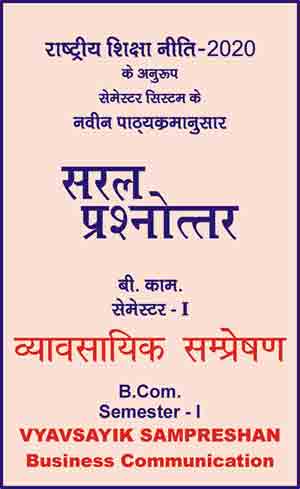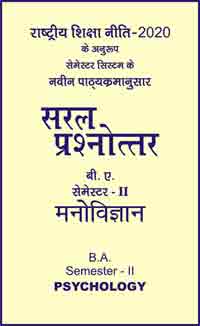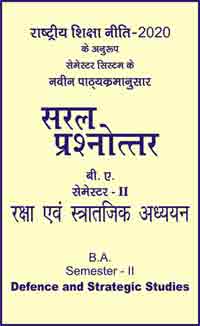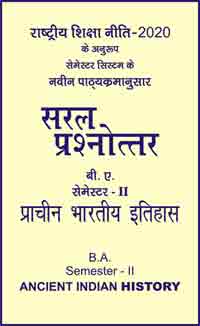|
बी काम - एम काम >> बीकाम सेमेस्टर-1 व्यावसायिक सम्प्रेषण बीकाम सेमेस्टर-1 व्यावसायिक सम्प्रेषणसरल प्रश्नोत्तर समूह
|
5 पाठक हैं |
||||||
बीकाम सेमेस्टर-1 व्यावसायिक सम्प्रेषण
प्रश्न- सामान्य भूलों से बचाव हेतु adjectives के सम्बन्ध में नियम दीजिये।
उत्तर -
(Rules regarding Adjectives to avoid common Errors)
1. दो वस्तुओं की तुलना करने के लिए हम adjective की comparative degree का * उपयोग करते हैं, दो वस्तुओं की तुलना करने हेतु superlative का उपयोग किया जाता है। यदि कोईतुलना न हो, तो हमें positive degree का उपयोग करना चाहिए -
(i) This is a very attractive plan.
(यहाँ कोई तुलना न होने से adjective attractive की positive degree हो। )
(ii) This is a more attractive plan than the one he suggested.
(दो plans के मध्य तुलना होने से objective attractive की comparative degree है )
(iii) This is the most attractive we have ever thought of (हमारे द्वारा सोचे गये सभी plans के बीच तुलना होने से adjective attractive की superlative degree है। )
यहाँ यह ध्यान दिया जाना चाहिए कि than के बाद comparative degree आती है; superlative degree अपने साम्य definite article the को रखती है।
(iv) ऐसे comparatives जिनके अन्त में or होता है, जैसे superior, senior,inferior, junior, prior आदि, तो इनके बाद to आता है।
You are senior to me by five years.
Giving agencies is preferable to setting up our own branches.
3. Adjectives जैसे few, a few तथा the few number के द्योतक होते हैं। Few का अर्थ है not many, वास्तविक रूप में almost more. A few का अर्थ होता है some at least. The few all of them, though very few:
(i) Few candidates turned up for the interview. (almost no candidate turned up).
(ii) There were still a few candidates eligible for appointment. (at least some candidates ).
(iii) The few candidates who turned up for the interview were not adequately qualified.
4. Chief, complete, extreme, full, ideal, unique, unanimous, universal आदि adjectives से highest degree प्रकट होती है तथा इनका उपयोग comparative या superlative degree में नहीं हो सकता है :
(i) He will make an ideal secretary.
(ii) This is a unique scheme.
5. Further को fore की comparative degree माना जाता है, यह something additional को बताता है।
Further को for की comparative degree माना जाता है तथा greater distance को व्यक्त होता है, अब इन सभी अर्थों में futher का उपयोग होता है। Farther तब तक सामान्यतया उपयोग नहीं होता जब तक कि दूरी शामिल न हो -
(i) Please read further.
(ii) Raju went to USA to explore further possibilities of exporting his products.
(iii) Further discussion will be held in the next week.
(iv) Mumbai is farther from NOIDA than Ahmedabad.
6. Many का प्रयोग plural noun से पहले होता है -
Many customers are going away dissatisfied.
Many a का प्रयोग singular noun से पहले होता है
Many a good scheme has failed for want of adequate financial support.
7. Much का अर्थ है a large quantity of तथा इसका उपयोग uncountables के साथ होता है।
Many का अर्थ है a large number of तथा इसके Plurals of countables के साथ प्रयोग करते हैं -
(i) Much discussion, much worry.
(ii) Many files, many projects.
8. Later व latest से समय का संकेत होता, latter तथा last से स्थिति इंगित होती है।
Later का अर्थ है more late in; time. Latter को former के उल्टा मानते हैं तथा इसका अर्थ the second in the order of original mentioning है। Latest का अर्थ है last up to now only. Last का अर्थ है last of all, final.
(i) Ramu came later than I expected.
(ii) Have you heard the latest news?
(iii) The director and the secretary took their seats. The latter read out the minutes.
(iv) The peon was the last person to leave the office room.
9. First से क्रम ( order) या दशा का संकेत मिलता है। Foremost से greatest importance का संकेत होता है।
10. Each 32 two or more than two things taken one by one. Every का भी यही अर्थ होता है, परन्तु each का उपयोग तब होता है जब समूह में संख्या सीमित व निश्चित होती है जबकि every का उपयोग तब होता है जब संख्या अनिश्चित होती है।
11. Outer से स्थिति utter से degree का संकेत होता है।
12. Nearest से दूरी का संकेत होता है जबकि next से स्थिति का -
(i) His office stands next to the Taj Hotel.
(ii) Whose house is nearest to the office?
13. Little का अर्थ. है not much. यह लगभग पूर्णतया negative adjective होता है। A Little का अर्थ. है
fat least some. The little का अर्थ. हैthe whole amount, though very little :
(i) I have little hope left of mysuccess. (practically no hope)
(ii) There is still a little hope left of his recovery. (some hope at least is
(iii) I have given up the little hope I had.
14. Some का प्रयोग affirmative वाक्य में होता है, any का उपयोग negative वाक्य में होता है
Some members have already sent their subscriptions.
|
|||||













